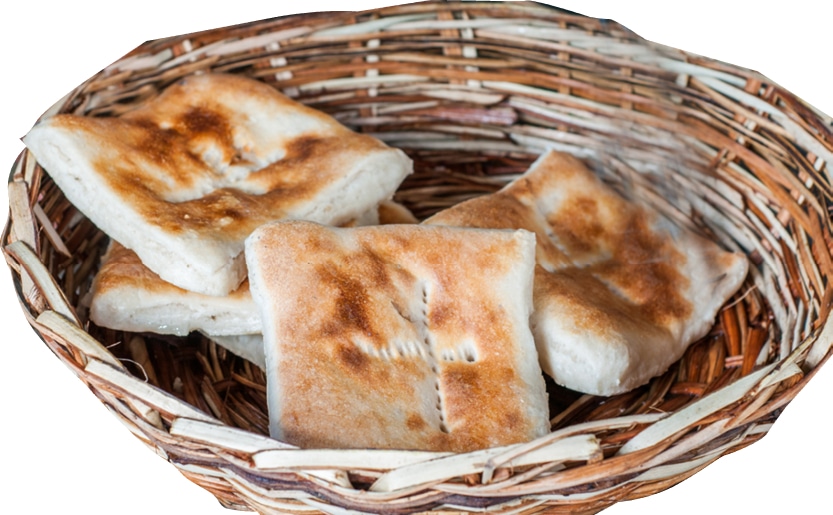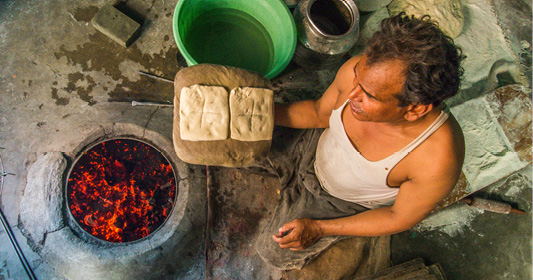While Hyderabad’s biryani and mirchi ka salan are famous worldwide, a little known naan has reigned supreme with food connoisseurs in the city for over a century and a half. Known as much as the place that makes it and the shape it comes in, this naan is an under-discovered gem of Hyderabad. Mallik Thatipalli gives us an insight into how this famed bread came into existence and what food it should be paired with. Photos courtesy Saurabh Chatterjee.
The History
The lore of Naan Munshi Sahab, which has been well documented, traces its origin to 1851. The fourth-generation owner Khaja Abdul Hameed shares, “My great-grandfather and founder of the naan, Mohammed Hussain Saheb, used to work as a munshi in one of the offices under the fourth Nizam of Hyderabad, Naseer-ud-Dowla. On a visit to Delhi, he learnt the recipe of the naan and started making it in Hyderabad.”

The shop got its name from the profession of its owner, and though the same stretch boasts of at least a dozen stalls selling similar naan, none is half as popular as its primogenitor.
Its location in the densely populated Purani Haveli area in the Old City (known as Haveli Khadeem in the past) ensured that it was a big hit, and local legend has it that it counted the Nizam as one of its patrons, ensuing in its dizzying rise to fame.
The square-shaped naanbecame an instant hit because of its ability to cater to a wide base of patrons. Crisp on the outside and soft on the inside, it became a poor man’s breakfast, as vegetarians paired it with milk or tea, while non-vegetarians could have it as an accompaniment with many traditional old-city dishes— from nihaari and paya to maraq, the clear lamb soup — a favorite of the working class.
Nearly 1400 naansare made on a regular day from two quintals of flour, with eight employees making fresh batches thrice a day, using the traditional underground tandoor bhatti.
While the establishment makes five different kinds of naan, the square-shaped one came into being as it was easier to hold it while on the move. Hameed says, “The Purani Haveli area wasn’t as affluent as the Charminar neighborhood and the clientele consisted mostly of workers. The bigger base made it easier for them to stand and eat it with a soup. It might also have been a trick of the trade to ensure that the product stood out from regular naansduring its inception. The size has remained the same over the years.”
Apart from the square-shaped naansmade daily, the other four varieties (usually made on order) are: paan naan(thicker at 140 grams per piece), taare ki naan or the star-shaped naan(popular for events involving children), sheermal or the round naan, and finally the lambi roti or the bada naanwhich is preferred for big family gatherings or festivities.

Tradition Rules the Roost
Naan Munshi Sahab still follows the old and time-honoured aspects of making naan. The ingredients remain the same (maida, oil, curd, salt, a smattering of elaichi and a secret ingredient in some seasons, which Hameed mentions as an afterthought, with a smile).
Nearly 1400 naansare made on a regular day from two quintals of flour, with eight employees making fresh batches at 7:30 am, 1:30 pm and 7 pm. They still use the traditional underground tandoor bhatti (a large structure consisting of a cooking pot built inside an insulating mud oven), which uses charcoal and gives a unique, smoke-y texture to the naan.
While most modern baking uses yeast, Munshi Naan sticks to the traditional Indian method of ‘proving’, where the dough is allowed to rest for 12-14 hours, giving it time to ‘rise’ and achieve a wholesome favor. Each evening, the mixture for the next day is hung from a cloth and retrieved in the morning.

The Enduring Legacy
Of late, thanks to a renewed interest in local cuisine amongst natives, Munshi naan has seen a surge in its popularity. While Munshi Naan has always had its devoted clientele in the old city of Hyderabad, it has been resurrected in popular parlance in the recent past, thanks to the increasing number of food walks being conducted in the city. These heritage food walks have introduced the gastronomical riches of an old cuisine to a tech-savvy generation of bloggers and Instagrammers, who have taken a fancy to its rich history and legacy apart from its unique taste.
Few foods can boast of having a 167-year-old legacy, and Munshi Naan symbolises the rich culture and cuisine of a city that has been one of India’s primary cities for well over 400 years now.

Whether or not it curries flavour with a new clientele, Munshi Naan occupies a place at the top echelons of old Hyderabadi cuisine. Hameed, who sticks to the practices started by his great-grandfather, is in no mood to tamper with any part of the routine. He says, “We are labour-intensive and have no intention of bringing out instant food like every other eatery in time. A delicacy is always enjoyed by a section of people, not everyone.”Few foods can boast of having a 167-year-old legacy, and Munshi Naan symbolises the rich culture and cuisine of a city that has been one of India’s primary cities for well over 400 years now.


























